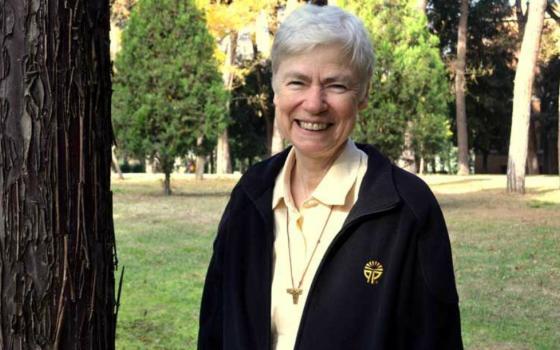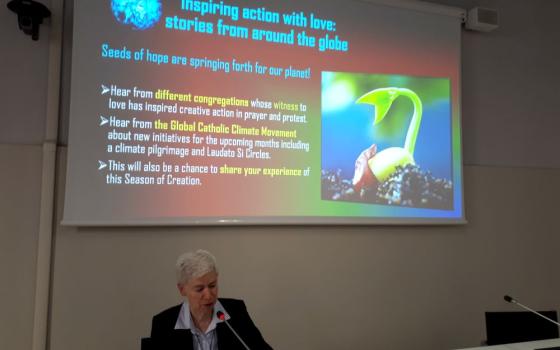At the May 6-10 triennial meeting in Rome of the International Union of Superiors General (UISG), leadership of women religious around the world received an update on a campaign that aims to place special focus on congregations' efforts to heed Pope Francis' call to environmental stewardship and their continued work to put his words into action.
Started in June 2018, the Sowing Hope for the Planet campaign challenged congregations to find ways, both personally and in their communities, to implement the message of the pope's encyclical "Laudato Si', on Care for Our Common Home."
Leading the effort has been Sr. Sheila Kinsey, a member of the Franciscan Sisters, Daughters of the Sacred Hearts of Jesus and Mary and executive co-secretary for UISG's Justice, Peace and Integrity of Creation Commission. That commission partnered with the Global Catholic Climate Movement to promote Sowing Hope for the Planet, with more than 250 congregations taking part. A survey launched in March has tracked sisters' participation, with the hope to identify best practices that can be expanded.
During the UISG assembly, Kinsey provided the 850 superiors general gathered there with a progress report on Sowing Hope for the Planet. Sisters were also encouraged to appoint contact people within their congregations to broaden the campaign, including through participation and support of the upcoming special synod on the Amazon, set for October in Rome.
Kinsey spoke with GSR by email in March about Sowing Hope for the Planet's genesis and how sisters have taken up the ecological cause.
GSR: What led UISG to take up the Sowing Hope for the Planet program?
Kinsey: On June 18, 2018, the UISG board launched a two-year campaign, Sowing Hope for the Planet, to share efforts of the sisters in putting Laudato Sí' into practice. Already, Laudato Si' had spread throughout religious communities, becoming a deeply meaningful connection with people and the Earth through faith and the words of Pope Francis.
This realization led to the awareness that this connection has the potential to develop a deeper interconnection, carrying the message into a global network of religious working together to "hear the cry of the Earth and the cry of the poor." Using this collective listening to create a collective voice and collective action carries greater potential for effect than we can offer alone.
Pope Francis has underlined the fundamental connection that exists between the environmental crisis and the social crisis we are currently experiencing. He asks us for a personal and communal ecological conversion, often reminding us, "Everything is interconnected."
Why did UISG decide to place this emphasis on putting Laudato Si' into practice now?
Part of the timing arises with the growing awareness and desperation of climate change and the urgent need to meet the challenges of global warming. Laudato Si' offers a spiritual relationship and solutions to a critical situation. This campaign offers a practical and spiritual platform for solutions that are so desperately needed right now.
It begins with awareness and unfolds with inspiration, giving the sisters' voice to their influential power to make a difference. The campaign coordinates experiences that provide the sisters and their connections the opportunities to become painfully aware of the needs of our common home so as to dare to turn what is happening to the world into their own personal suffering and thus to discover what each of us can do about it.
How many congregations have participated?
Approximately 394 sisters from 265 communities have registered with the campaign through the website and the webinars.
What are some of the ways congregations have participated?
Congregations have been rising to the message of Laudato Si' since it was first published. Many congregations have shared a variety of inspiring ways they are implementing it within their communities and missions.
There are many who are engaging Laudato Si', bringing in the whole community in shared reflection with study sessions; developing resources to teach parents, teachers and catechists how to implement Laudato Si'; and reflection groups, some of which are also reading books that develop the themes of Laudato Si'. Creative use of both faith and scientific resources are also being used to draw on and integrate what is available. One group has used holy books such as the Bible and Bhagavad Gita, and another has developed a cosmology group using scientists as speakers. Both offer examples of how faith and science come together in support of our common goals.
Congregations are beautifully using church services as a platform to offer liturgical resources, offertory petitions, closing blessings, accepting the world as a sacrament of communion and offering a Laudato Si' quote from a basket to reflect on during the week. These efforts engage both congregation and community and are very easily incorporated into regular services, offer a sense of involvement and commitment to the care for our Earth, and create meaningful connections together. Other inspiring acts in church locations include decorating the chapel with icons of the biblical creation story surrounded by plants and flowers, celebrating the Season of Creation [annually from Sept. 1 through Oct. 4] within the congregation and the dedication of a cosmic walk path.
Advocacy and the effort to raise awareness is seen in many community efforts: writing newsletter articles, offering education about the ongoing devastation caused by burning wood or charcoal, the formation of a parish care-of-Earth group to promote and care for the environment in the local community, and raising awareness on changing lifestyles and common household care. One group became more aware of the harmful effects of plastics and the misuse of paper and electricity, which has allowed their use of them to be curbed.
Engaging in commitment and action, communities have offered many different opportunities for concrete action at the local level. Some events include sisters writing a commitment to the planet during an Oct. 4 celebration [the feast of St. Francis of Assisi]; potlucks at church-sponsored events using biodegradable cold cups, which can be composted with food waste; education and action in understanding food, such as fair-trade articles, waste management (composting and recycling) and ecological cleaning products. These are beautiful demonstrations of concrete ways we can engage in our daily lives and communities. One community is even supporting a project to offset their carbon footprint by contributing to a fund for the development and care of Earth projects in countries of Africa. Coming together in this way, our united voice reaches out into the world.
Understanding the need for expertise, there has even been seeking of professional assistance, such as with water and energy, by engaging with external consultants to assess energy consumption; this resulted in changing the heating system, lights and several other elements that are saving money and reducing greenhouse gas emissions. This offers another way that awareness of our own consumption can lead to significant change.
Are there any efforts in particular that stand out?
It is difficult to think of just one. These relevant and inspiring experiences have made a difference in people's lives. They allow for an engagement in meaningful prayer, significant connections, and the creation of networks, as well as allowing our hearts, our hands and our spirits to be engaged in the care of our common home.
How would you assess the implementation of Laudato Si' so far within the church and within women religious congregations? What are next steps?
There are many Catholic organizations engaged in the implementation of Laudato Sí'. We are collaborating with the Global Catholic Climate Movement (GCCM), which works within the Catholic Church to better care for our common home. GCCM has records of their involvements within the Catholic Church. The founding document is Pope Francis' encyclical Laudato Si'.
We also work with the Vatican Dicastery for Promoting Integral Human Development and have participated in their conferences. We have gained additional contacts through those experiences.
What is the importance of higher levels of church structures taking an active role in implementing Laudato Si' — for example, UISG with Sowing Hope for the Planet — for its adoption within the wider church and for creation care to be seen as a bigger priority?
One major opportunity provided by the campaign is to raise a collective voice and develop a collective strength to impact what is happening in our world. One thing that is clear in our history is that designated power structures usually are given the bigger say in what is happening and, often, are the loudest voice.
UISG is a unifying voice for the sisters around the world. Through this campaign, we have the opportunity to organize the voice of the sisters in the effort on many levels of structures in order to enhance and recognize our contribution to the care of our common home.
[Brian Roewe is an NCR staff writer. His email address is broewe@ncronline.org. Follow him on Twitter @BrianRoewe.]



